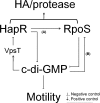Interplay among cyclic diguanylate, HapR, and the general stress response regulator (RpoS) in the regulation of Vibrio cholerae hemagglutinin/protease
- PMID: 21965573
- PMCID: PMC3232884
- DOI: 10.1128/JB.05166-11
Interplay among cyclic diguanylate, HapR, and the general stress response regulator (RpoS) in the regulation of Vibrio cholerae hemagglutinin/protease
Abstract
Vibrio cholerae secretes the Zn-dependent metalloprotease hemagglutinin (HA)/protease (mucinase), which is encoded by hapA and displays a broad range of potential pathogenic activities. Expression of HA/protease has a stringent requirement for the quorum-sensing regulator HapR and the general stress response regulator RpoS. Here we report that the second messenger cyclic diguanylic acid (c-di-GMP) regulates the production of HA/protease in a negative manner. Overexpression of a diguanylate cyclase to increase the cellular c-di-GMP pool resulted in diminished expression of HA/protease and its positive regulator, HapR. The effect of c-di-GMP on HapR was independent of LuxO but was abolished by deletion of the c-di-GMP binding protein VpsT, the LuxR-type regulator VqmA, or a single-base mutation in the hapR promoter that prevents autorepression. Though expression of HapR had a positive effect on RpoS biosynthesis, direct manipulation of the c-di-GMP pool at a high cell density did not significantly impact RpoS expression in the wild-type genetic background. In contrast, increasing the c-di-GMP pool severely inhibited RpoS expression in a ΔhapR mutant that is locked in a regulatory state mimicking low cell density. Based on the above findings, we propose a model for the interplay between HapR, RpoS, and c-di-GMP in the regulation of HA/protease expression.
Figures







Similar articles
-
The LuxR-type regulator VpsT negatively controls the transcription of rpoS, encoding the general stress response regulator, in Vibrio cholerae biofilms.J Bacteriol. 2014 Mar;196(5):1020-30. doi: 10.1128/JB.00993-13. Epub 2013 Dec 20. J Bacteriol. 2014. PMID: 24363348 Free PMC article.
-
Transcriptional regulation of Vibrio cholerae hemagglutinin/protease by the cyclic AMP receptor protein and RpoS.J Bacteriol. 2004 Oct;186(19):6374-82. doi: 10.1128/JB.186.19.6374-6382.2004. J Bacteriol. 2004. PMID: 15375117 Free PMC article.
-
DksA-HapR-RpoS axis regulates haemagglutinin protease production in Vibrio cholerae.Microbiology (Reading). 2017 Jun;163(6):900-910. doi: 10.1099/mic.0.000469. Epub 2017 Jun 8. Microbiology (Reading). 2017. PMID: 28597815
-
The ins and outs of cyclic di-GMP signaling in Vibrio cholerae.Curr Opin Microbiol. 2017 Apr;36:20-29. doi: 10.1016/j.mib.2017.01.002. Epub 2017 Feb 5. Curr Opin Microbiol. 2017. PMID: 28171809 Free PMC article. Review.
-
Roles of the second messenger c-di-GMP in bacteria: Focusing on the topics of flagellar regulation and Vibrio spp.Genes Cells. 2022 Mar;27(3):157-172. doi: 10.1111/gtc.12921. Epub 2022 Jan 24. Genes Cells. 2022. PMID: 35073606 Free PMC article. Review.
Cited by
-
Interaction of the histone-like nucleoid structuring protein and the general stress response regulator RpoS at Vibrio cholerae promoters that regulate motility and hemagglutinin/protease expression.J Bacteriol. 2012 Mar;194(5):1205-15. doi: 10.1128/JB.05900-11. Epub 2011 Dec 22. J Bacteriol. 2012. PMID: 22194453 Free PMC article.
-
Cheater suppression and stochastic clearance through quorum sensing.PLoS Comput Biol. 2022 Jul 28;18(7):e1010292. doi: 10.1371/journal.pcbi.1010292. eCollection 2022 Jul. PLoS Comput Biol. 2022. PMID: 35901008 Free PMC article.
-
Comparative Transcriptome Analysis of Vibrio splendidus JZ6 Reveals the Mechanism of Its Pathogenicity at Low Temperatures.Appl Environ Microbiol. 2016 Jan 22;82(7):2050-2061. doi: 10.1128/AEM.03486-15. Appl Environ Microbiol. 2016. PMID: 26801576 Free PMC article.
-
H-NS: an overarching regulator of the Vibrio cholerae life cycle.Res Microbiol. 2017 Jan;168(1):16-25. doi: 10.1016/j.resmic.2016.07.007. Epub 2016 Aug 1. Res Microbiol. 2017. PMID: 27492955 Free PMC article. Review.
-
Basic Characterization of Natural Transformation in a Highly Transformable Haemophilus parasuis Strain SC1401.Front Cell Infect Microbiol. 2018 Feb 8;8:32. doi: 10.3389/fcimb.2018.00032. eCollection 2018. Front Cell Infect Microbiol. 2018. PMID: 29473023 Free PMC article.
References
Publication types
MeSH terms
Substances
Grants and funding
LinkOut - more resources
Full Text Sources

